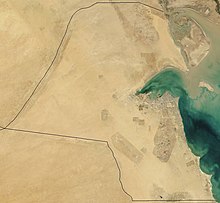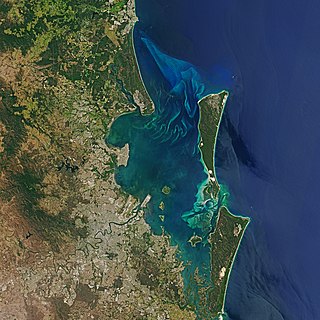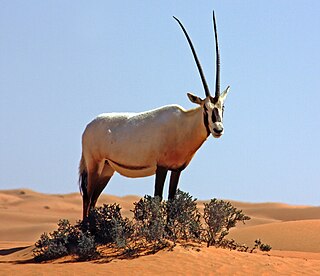
The wildlife of Kuwait consists of the flora and fauna of Kuwait and their natural habitats. Kuwait is a country in the Middle East at the head of the Persian Gulf, located between Iraq and Saudi Arabia.

The wildlife of Kuwait consists of the flora and fauna of Kuwait and their natural habitats. Kuwait is a country in the Middle East at the head of the Persian Gulf, located between Iraq and Saudi Arabia.
Kuwait is 17,820 km2 (6,880 sq mi) in size, being about 200 km (124 mi) from north to south and 170 km (106 mi) from east to west. It has 195 km (121 mi) of coastline on the Persian Gulf and includes nine islands, the largest being Bubiyan Island. The main geographical feature is the large Kuwait Bay, which provides a natural harbour and on the shores of which Kuwait City is located. [1] The country consists largely of undulating flat land with low hills. The country is divided into four zones; a desert plateau to the west; salt marshes, mud flats and saline depressions around Kuwait Bay; sand dunes to the east; and a desert plain occupying the bulk of the country. [2]
Kuwait has an arid climate. The summer is hot and dry and the precipitation, which averages less than 8 cm (3.1 in) falls mainly in the winter in the form of unpredictable showers and as thunderstorms in spring. Dust storms can occur at any time of year but are more common in spring and summer. Average daily temperatures in the summer are around 43 °C (109 °F). In the winter, average temperate are 13 °C (55 °F), and there can be night frosts. [2] Due to Kuwait's proximity to Iraq and Iran, the winter season in Kuwait is colder than other Arabian Peninsula countries.

Over 400 species of wild plant have been recorded in Kuwait. The arfaj is the national flower of Kuwait. [3] Desert plants are typically coarse grasses and salt-tolerant shrubs which tend to be low growing and often spiny; one of the most common plants is Rhanterium epapposum , known locally as arfaj, which is used for forage by camels and sheep. After rainfall, annual plants spring up from seeds which may have lain dormant for years. The flowers they produce are often blue or purple and as soon as the seed is set, the plants wither and die. [4] About two thirds of the plant species are annuals with smaller numbers of perennial plants, shrubs and sub-shrubs. The native flora is in transition between semi-desert and desert vegetation and is of importance in the study of how humans are impacting semi-desert habitats. The aftermath of the Gulf War and the inundation of much of the land with hydrocarbon residues has caused considerable damage to the soil structure and considerable changes to the environment. [5] Date palms have been planted at oases and near the coast and mangroves and sea grasses grow on the mudflats near Kuwait Bay, their roots helping to stabilise the coastline. [4]

Currently, 442 species of birds have been recorded in Kuwait, 18 species of which breed in the country. [6] Kuwait is situated at the crossroads of several major bird migration routes and between two and three million birds pass each year. [7] The marshes in northern Kuwait and Jahra have become increasingly important as a refuge for passage migrants. [7] Kuwaiti islands are important breeding areas for four species of tern and the socotra cormorant. [7]
The Mubarak Al-Kabeer Reserve Ramsar Site on Boubyan Island consists of lagoons and saltmarshes and is visited annually by wetland birds migrating from Eurasia to Africa, and others travelling from Turkey to India. Other birds live and breed on these wetlands all year round, including the world's largest breeding colony of crab-plovers. [8] Among the resident birds, the commonest is the desert lark, and inland the kestrel and short-toed snake eagle are to be seen hunting over the desert. [9]
Away from the coast the searing heat and absence of surface water means that animals need to have special adaptations and behaviours to survive. Kuwait has only one species of amphibian, the variable toad (Bufotes variabilis), and has about 38 species of reptile. These include the Arabian sand boa, the black desert cobra, the monitor lizard and a number of different spiny-tailed lizards (Uromastyx spp.). Many of these spend the heat of the day in burrows, emerging at night to feed. The frog-eyed gecko (Teratoscincus scincus) does this, burrowing as deep as 1.2 m (4 ft) below the surface among the dunes of the coastal plains, where it remains cool and humid. [10]
Around 28 species of mammals have been recorded in the country. [5] Terrestrial mammals include several small desert rodents, the desert hedgehog, the African wildcat, the sand cat, the caracal, the Indian grey mongoose, the striped hyena, the golden jackal, the fennec fox, the honey badger, the Saudi gazelle, the goitered gazelle, the Arabian oryx, the dromedary and two species of bat. The dugong has been recorded in Kuwaiti waters in the Persian Gulf, as well as the Bryde's whale, the pygmy blue whale, the humpback whale, the finless porpoise, the Indo-Pacific humpbacked dolphin and the Risso's dolphin. [11]
Scorpions and dung beetles abound, and in the wetlands and mudflats around Kuwait Bay and the islands there are crabs and mudskippers, numerous species of fish, waterfowl, gulls, flamingoes and dugongs. [9]

Kuwait is a country in West Asia, bordering the Persian Gulf, between Iraq and Saudi Arabia. Kuwait is located at the far northwestern corner of the Persian Gulf. Kuwait is 17,820 square kilometres in size. At its most distant points, it is about 200 km (120 mi) north to south, and 170 km (110 mi) east to west. Kuwait has 10 islands. Kuwait's area consists mostly of desert.

The Persian Gulf, sometimes called the Arabian Gulf, is a mediterranean sea in West Asia. The body of water is an extension of the Indian Ocean located between Iran and the Arabian Peninsula. It is connected to the Gulf of Oman in the east by the Strait of Hormuz. The Shatt al-Arab river delta forms the northwest shoreline.

Moreton Bay is a bay located on the eastern coast of Australia 14 kilometres (8.7 mi) from central Brisbane, Queensland. It is one of Queensland's most important coastal resources. The waters of Moreton Bay are a popular destination for recreational anglers and are used by commercial operators who provide seafood to market.

The Arabian Desert is a vast desert wilderness in West Asia that occupies almost the entire Arabian Peninsula with an area of 2,330,000 square kilometers (900,000 sq mi). It stretches from Yemen to the Persian Gulf and Oman to Jordan and Iraq. It is the fifth largest desert in the world and the largest in Asia. At its center is Ar-Rub' al-Khali, one of the largest continuous bodies of sand in the world. It is an extension of the Sahara Desert.

The Gulf of Bahrain is an inlet of the Persian Gulf on the east coast of Saudi Arabia, separated from the main body of water by the peninsula of Qatar. It surrounds the islands of Bahrain. The King Fahd Causeway crosses the western section of the Gulf of Bahrain, connecting Saudi Arabia to Bahrain.

The wildlife of Jordan includes its flora and fauna and their natural habitats. Although much of the country is desert, it has several geographic regions, each with a diversity of plants and animals adapted to their own particular habitats. Fossil finds show that in Palaeolithic times, the region had Syrian brown bears, Asiatic lions, zebras, Asian elephants, and rhinoceroses, but these species are all now extinct in this region.

The wildlife of Egypt is composed of the flora and fauna of this country in northeastern Africa and southwestern Asia, and is substantial and varied. Apart from the fertile Nile Valley, which bisects the country from south to north, the majority of Egypt's landscape is desert, with a few scattered oases. It has long coastlines on the Mediterranean Sea, the Gulf of Suez, the Gulf of Aqaba and the Red Sea. Each geographic region has a diversity of plants and animals each adapted to its own particular habitat.
Mauritania's wildlife has two main influences as the country lies in two biogeographic realms. The north sits in the Palearctic which extends south from the Sahara to roughly 19° north latitude and the south is in the Afrotropic realm. Additionally Mauritania is an important wintering area for numerous birds which migrate from the Palearctic.

The wildlife of Libya is spread over the Mediterranean coastline and encompasses large areas of the Saharan desert. The protection of wildlife is provided through appropriate legislation in seven national parks, five reserves, 24 protected areas, two wetlands under Ramsar Convention, and also in other areas. Apart from these, there are also five UNESCO World Heritage Sites related to culture. The most important national parks are the El-Kouf National Park and Karabolli National Park. The well known nature reserves are the Benghazi Reserve and the Zellaf Reserve. The wildlife species recorded in the country are 87 mammals and 338 species of birds.

The wildlife of Qatar includes the peninsula's flora and fauna and their natural habitats. The country's terrestrial wildlife includes numerous small nocturnal mammals, a number of reptiles which mainly consist of lizard species, and arthropods. Aquatic animals primarily include fish, shrimp and pearl oysters. The desert and the shoreline form an important resting site for migratory bird species during autumn and spring. Urban and agricultural developments have led to an increase in bird species.
The wildlife of Yemen is substantial and varied. Yemen is a large country in the southern half of the Arabian Peninsula with several geographic regions, each with a diversity of plants and animals adapted to their own particular habitats. As well as high mountains and deserts, there is a coastal plain and long coastline. The country has links with Europe and Asia, and the continent of Africa is close at hand. The flora and fauna have influences from all these regions and the country also serves as a staging post for migratory birds.

The wildlife of Saudi Arabia is substantial and varied. Saudi Arabia is a very large country forming the biggest part of the Arabian Peninsula. It has several geographic regions, each with a diversity of plants and animals adapted to their own particular habitats. The country has several extensive mountain ranges, deserts, highlands, steppes, hills, wadis, volcanic areas, lakes and over 1300 islands. The Saudi Arabian coastline has a combined length of 2,640 km (1,640 mi) and consists of the Gulf of Aqaba and the Red Sea to the west while a shorter eastern coastline can be found along the Persian Gulf.
The wildlife of Bahrain is the flora and fauna of the archipelago of Bahrain. Apart from a strip of the north and west of the main island, where crops such as potatoes are grown with irrigation, the land is arid. With a very hot dry summer, a mild winter, and brackish groundwater, the plants need adaptations in order to survive. Nevertheless, 196 species of higher plant have been recorded here, as well as about seventeen species of terrestrial mammals, many birds and reptiles, and many migratory birds visit the islands in autumn and spring.

The wildlife of the United Arab Emirates is the flora and fauna of the country on the eastern side of the Arabian Peninsula and the southern end of the Persian Gulf. The country offers a variety of habitats for wildlife including the coast, offshore islands, mangrove areas, mudflats, salt pans, sand and gravel plains, sand dunes, mountain slopes, wadis and rocky summits. Because the terrain is so varied, it supports a greater number of species of plants and animals than might have been expected in this relatively small country.

The wildlife of Oman is the flora and fauna of this country in the southeastern corner of the Arabian Peninsula, with coasts on the Gulf of Oman and the Arabian Sea. The climate is hot and dry, apart from the southeastern coast, and the country offers a variety of habitats for wildlife including mountains, valleys, deserts, coastal plains and sea coasts.

The Persian Gulf desert and semi-desert ecoregion covers the desert coastal plain of the northwest Persian Gulf, that is, on the northeast Arabian Peninsula, from Kuwait in the north to a small coastal sector in the United Arab Emirates to the southeast.
{{cite web}}: CS1 maint: date and year (link)